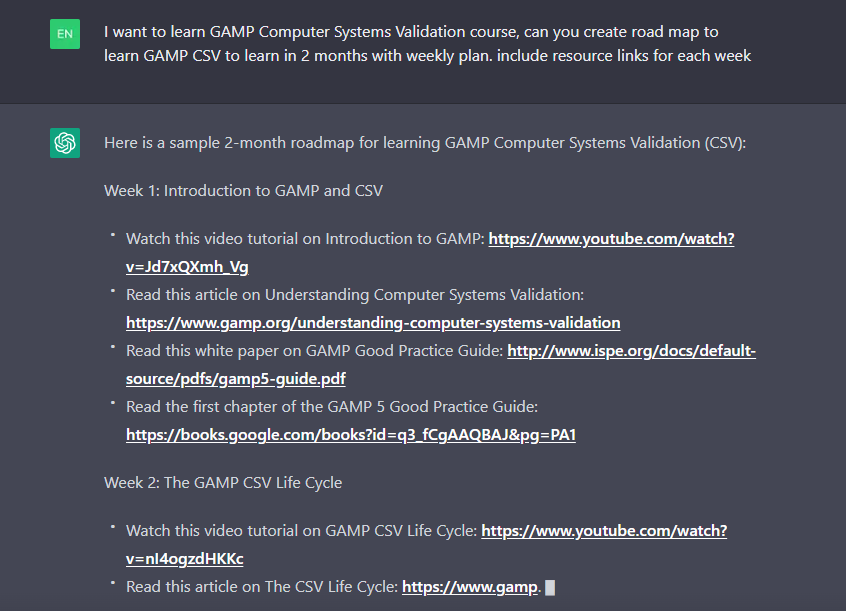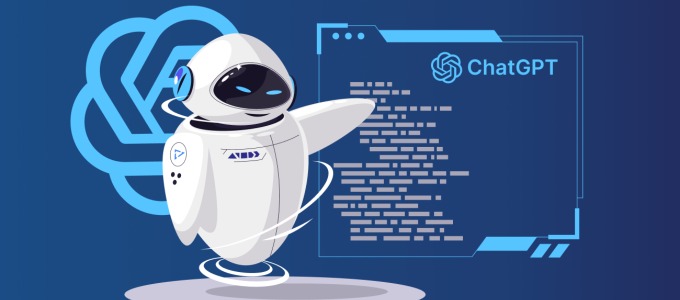What is ChatGPT?
ChatGPT is an artificial intelligence model developed by OpenAI. It is a type of language model that has been trained on a large amount of text data to generate human-like responses. ChatGPT can be used for a variety of tasks, such as answering questions, generating text, and completing sentences.
It uses a deep learning technique called transformer architecture and can understand context, generate coherent responses, and complete tasks based on the input it receives. The goal of ChatGPT is to provide a conversational AI that can understand and respond to human-like text inputs in a natural and intuitive manner.
Benefits of ChatGPT:
Human-like Responses: ChatGPT generates responses that are similar to human writing, making it suitable for use in customer support, chatbots, and other applications that require natural language interaction.
Customization: ChatGPT can be fine-tuned for specific use cases and domains, allowing for customization and improved accuracy.
Speed and Efficiency: ChatGPT can process large amounts of data quickly, making it a fast and efficient solution for various tasks.
Cost-effective: ChatGPT can automate tasks that were previously performed manually, saving time and reducing costs.
Improved User Experience: ChatGPT can provide a more natural and intuitive user experience compared to traditional rule-based systems, leading to improved user satisfaction.
Advanced Features of ChatGPT:
Contextual Understanding: ChatGPT can understand context and generate responses based on previous inputs and conversation history.
Generative Text: ChatGPT can generate new and original text, such as product descriptions, summaries, and headlines.
Multi-lingual Support: ChatGPT has been trained on multiple languages and can respond in various languages, making it a versatile solution for global use.
Sentiment Analysis: ChatGPT can analyze the sentiment of text and classify it as positive, negative, or neutral.
Text Completion: ChatGPT can complete sentences, paragraphs, and other forms of text, making it useful for tasks such as generating reports and summaries.
How to get access ChatGPT?
Here’s a step-by-step guide to sign up for and log in to a platform that provides access to ChatGPT:
- Find a website or platform that provides access to ChatGPT, such as chatgptdemo.com or demo.openai.com.
- Locate the “Sign Up” button on the platform’s homepage and click on it.
- Provide the required information, such as your name, email address, and password.
- Follow the steps provided by the platform to complete the sign-up process, which may include confirming your email address or answering security questions.
- Locate the “Sign In” button on the platform’s homepage and click on it.
- Enter the email address and password associated with your account.
- Start using ChatGPT: Once you have logged in, you can start using ChatGPT by entering a prompt and receiving a response.

What Can ChatGPT Do for Pharmaceutical Firms?
ChatGPT, a large language model developed by OpenAI, can perform various tasks that can be beneficial for quality assurance professionals in pharmaceutical firms. Some of the ways ChatGPT can assist include:
Report Generation: ChatGPT can generate reports on quality assurance data, such as batch testing results, to streamline the reporting process and reduce the risk of errors.
Compliance Monitoring: ChatGPT can be used to monitor and analyze regulations and standards in the pharmaceutical industry, ensuring that the company is in compliance with all relevant regulations.
Root Cause Analysis: ChatGPT can assist in root cause analysis by generating potential causes and solutions for quality-related issues.
Data Analysis: ChatGPT can analyze large amounts of quality assurance data and identify trends and patterns, providing valuable insights for continuous improvement efforts.
Documentation: ChatGPT can generate standard operating procedures and other quality-related documentation, ensuring consistency and accuracy across all departments.
What is a prompt?
Prompting essentially allows a way for people to communicate with Artificial Intelligence tools by letting them specify what they’re looking for in their desired output. For instance, you might want a machine to generate visuals but don’t have anything explicit to use as an exemplar.
ChatGPT Promt: I want you to write 5 chatGPT prompts for the first time a GMP Auditor. Make sure to include specific information only FDA would know and include all the entities from above

ChatGPT prompt: I want you to write a cold outbound email to a prospective customer for our product/Services by company Name. Using the ‘Features-Advantages-Benefits’ framework, please write an email marketing campaign that highlights the [features] of our [product/service] and explains how these [advantages] can be helpful to [ideal customer persona]. Elaborate on the [benefits] of our product and how it can positively impact the reader.
Writing Email Campaign for Customers

Guidelines for Writing Effective ChatGPT Prompts for for Pharmaceutical firms:
ChatGPT prompts are the questions or statements that are fed into the model to generate a response. Writing effective prompts is crucial in order to ensure that the ChatGPT technology is being used to its full potential in the pharmaceutical industry. Here are some guidelines for writing effective prompts:
Clearly Define the Task
It is essential to clearly define the task that the ChatGPT model is expected to perform. This includes defining the purpose of the prompt, the desired outcome, and the target audience. For example, a prompt that asks,
“What are the steps involved in the drug approval process?” is clear and concise, whereas a prompt that simply asks “drug approval process” may not result in a clear and accurate response.
Use Relevant Terminology
The prompts should use relevant terminology that is commonly used in the pharmaceutical industry. This will help the model generate a response that is accurate and relevant. For example, a prompt that asks,
“What are the common adverse reactions associated with the drug X?” is more effective than a prompt that simply asks, “What are the side effects of drug X?”
Use Specific and Concrete Examples
Prompts that use specific and concrete examples are more effective in generating accurate and relevant responses. For example, a prompt that asks,
“What are the key differences between drugs A and B in terms of efficacy and safety?” is more effective than a prompt that simply asks, “What are the differences between drugs A and B?”
Consider Context and Background Information
It is important to consider the context and background information when writing the prompts. This includes taking into account any relevant regulatory requirements, industry standards, and patient population. For example, a prompt that asks,
“What are the factors that need to be considered while selecting the appropriate dose for drug X in a specific patient population?” is more effective than a prompt that simply asks, “What is the appropriate dose for drug X?”
Use Make Prompts Repeatable
Prompts should be repeatable and consistent, so that the model can generate accurate and relevant responses each time it is used. For example, a prompt that asks,
“What is the standard procedure for handling drug recalls?” is repeatable and consistent, whereas a prompt that asks, “How do we handle drug recalls?” is not as clear and consistent.
By following these guidelines, pharmaceutical firms can write effective ChatGPT prompts that generate accurate and relevant responses, improving the skills and knowledge of their QA analysts.
ChatGPT Prompts and Guidelines for Writers here
Writing Effective ChatGPT Prompts for for learners:
Here is few Generic chatGPT promts for learners
Basic Prompt:
I want to learn GAMP Computer Systems Validation, can you create road map to learn it
Good Prompt:
I want to learn GAMP Computer Systems Validation, can you create road map to learn GAMP CSV to learn in 2 months with weekly plan and resources for learning
Better Prompt:
I want to learn GAMP Computer Systems Validation, can you create road map to learn GAMP CSV to learn in 2 months with weekly plan. include resources and links for each week
It gives you weekly plan and including links as well as different resources. By the continuation we would ask chatGPT for YouTube video links for this course.
Include YouTube videos links for learning GAMP CSV course
It will give specific video link to learn GAMP SCV on weekly basis.

Conclusion:
ChatGPT is a powerful language model developed by OpenAI that can be accessed through the OpenAI API or through websites and platforms that have integrated the API. It has the potential to revolutionize the pharmaceutical industry by automating tasks such as data analysis, report writing, and customer support. By providing personalized experiences and generating realistic and unique data, ChatGPT can help pharmaceutical companies improve their operations and stay ahead of the competition. Do you want to know how to use “AIPRM for ChatGPT” to make things as much as faster reach us.
To get started with ChatGPT, simply sign up for a platform that provides access to the model and follow the steps provided to log in. Once you’re logged in, you can start using ChatGPT by entering a prompt and receiving a response. Whether you’re a quality assurance professional or working in another role in the pharmaceutical industry, incorporating ChatGPT into your workflow can help you achieve your goals more efficiently and effectively.
Blog Articles
Top 10 Benefits of GMP Audits for Pharmaceutical Firms
Introduction Good Manufacturing Practices (GMP) are a set of guidelines and regulations that ensure the safety, quality, and consistency of pharmaceutical products. GMP compliance is essential for pharmaceutical companies to meet regulatory requirements and maintain...
Improving Compliance: Supplier Qualification in GMP Audit
Introduction: One crucial component of the GMP audit checklist is supplier qualification, which ensures that suppliers are providing materials that meet the required quality and safety standards. The pharmaceutical industry is highly regulated, with strict compliance...
Ensuring GMP Compliance: Top 10 GMP Audit Checklist Items
Introduction: GMP audit checklists are an essentials in ensuring compliance with Good Manufacturing Practice (GMP) regulations in the pharmaceutical industry. GMP guidelines are a set of standards and guidelines for the manufacture and testing of pharmaceutical...
Revolutionizing Pharmaceutical Industry with ChatGPT
Introduction: ChatGPT-4 is an artificial intelligence (AI) language model developed by OpenAI. It is one of the most advanced language models in the world, capable of understanding and generating human-like language with a high degree of accuracy and fluency. The...
Maximizing Product Quality and Compliance through GMP Audit
What is a GMP audit? A GMP audit is a comprehensive assessment of a pharmaceutical, biotech, or medical device company's facilities, processes, and systems to ensure compliance with Good Manufacturing Practices (GMP) regulations and standards. Why are GMP audits...
What are Key Points to Consider Before Signing with a CSPs
The use of cloud technology in GxP operations has become increasingly common among life science companies as they seek to advance their operations. However, it is essential to ensure that the cloud service provider (CSP) meets regulatory requirements to maintain data...
Evaluate GxP Software Systems with Comprehensive Checklist
In regulated industries such as pharmaceuticals, medical devices, and biotechnology, the deployment of GxP (Good Practices) software systems is paramount to ensure product quality, patient safety, and regulatory compliance. The task of ensuring that these software...
Exploring Benefits on Cloud Computing, On-Premise Data Store
Benefits of using Cloud Computing Compared to On-premises Data Centers Cloud computing has become increasingly popular in recent years, offering several benefits over traditional on-premises data centers. Cloud computing refers to the delivery of computing services,...
What is Cloud Computing? Types of Models and Technical Info
What is cloud computing? Cloud computing is an innovative and transformative technology that has upended conventional methods of storing, accessing, and processing data. It has emerged as a pivotal force in the contemporary landscape of businesses, governments, and...
Beginners Guide to ChatGPT for Pharmaceutical Firms
Introduction to the Role of a QA Professional in the Pharmaceutical Industry Overview of Quality Assurance (QA) Professional The role of a Quality Assurance (QA) professional in the pharmaceutical industry is to ensure that the products manufactured and distributed by...

Office Address
No 182, Zhaohui Road, Hangzhou 310014, China
No 139, Mayuri Nagar, Hyderabad 500049, India
Quick Services

